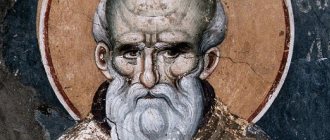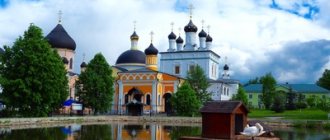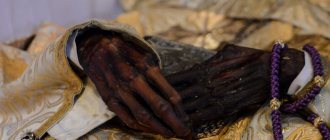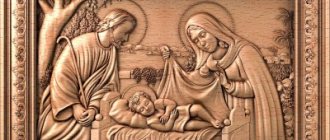Holiness
(gr. άγιότης, lat. sanctitas), one of the fundamental concepts of Christian teaching. Its main meaning is man’s participation in God, his deification in his transformation under the influence of God’s grace. In the transformed man, his nature undamaged by sin, his union with God as a “child of God,” is restored.
The basis of this restoration is the Incarnation, Christ's perception of human nature. Since human nature was deified in Christ, this opened the way to God for all humanity: Christians, following Christ, participate in his Divinity by grace and become saints.
In the First Council Epistle of the Apostle Peter, he, addressing Christians, says: “But you are a chosen race, a royal priesthood, a holy nation, a people taken for His own possession... Once not a people, but now the people of God; who once received no mercy, but now have received mercy” (1 Pet. 2:9-10). Entry into holiness is accomplished through Christ: “But, following the example of the Holy One who called you, be holy yourselves in all your actions; for it is written: Be holy, for I am holy” (1 Pet. 1:15-16).
This understanding of Christians as the people of God is based on the words of Christ himself, spoken by Him to His disciples: “In that day you will know that I am in My Father, and you in Me, and I in you” (John 14:20); Christ “gave to those who received Him, to those who believed in His name, the power to become children of God” (John 1:12). With precisely this understanding of holiness in mind, the Apostle Paul addresses Christian communities as assemblies of saints: “To all those who are in Rome beloved of God, called saints” (Rom. 1:7); “to all the saints in Christ Jesus who are in Philippi” (Phil. 1:1); “to the saints who are at Ephesus and faithful in Christ Jesus” (Eph. 1:1); “the church of God which is in Corinth, with all the saints throughout all Achaia” (2 Cor. 1:1).
The understanding of the Christian community as a community of friends of God, a “holy people” was most fully expressed in the liturgical life of the ancient church, since it was the Eucharist that was the center and basis of this life, the basis of worship and the basis of teaching.
As St. wrote. Irenaeus of Lyons (+ c. 200), “our teaching is in agreement with the Eucharist, and the Eucharist, in turn, confirms our teaching.” The oldest Eucharistic prayers that have come down to us speak of the “holy people” that Christ, the Son of God, acquired for the Father (for example, in the Eucharistic prayer given in the “Apostolic Tradition” of St. Hippolytus of Rome, describing Roman liturgical practice of the 3rd century). This “holy people” is identified with the community participating in worship and partaking of the Body and Blood of Christ. The Eucharistic prayer, given in the “Teaching of the Twelve Apostles” (“Didache”, no later than c.), ends with the words: “Whoever is holy (άγιός), let him come, and whoever is not, let him repent. Maranatha (The Lord is coming). Amen” (chap. X).
The idea of the holiness of the communion community is preserved in the modern rite of the Orthodox liturgy, when the priest, after reading “Our Father” and before communion, proclaims: “Holy to the saints (Τά άγια τοîς άγίοις),” to which the community (choir) responds with the words: “One is Holy, There is one Lord, Jesus Christ, to the glory of God the Father. Amen,” - the Holy Gifts (“Holy) are given to the saints, and their holiness is the holiness of Christ, with whom they are united in the sacrament (evidence of the exclamation “Holy to Holies” is in the catechetical writings of St. Cyril of Jerusalem in 348).
This moment of the Eucharistic service contains a certain theological concept of holiness. The Eucharist is the union of the faithful (faithful) with God, the realization of the Kingdom of God in historical existence moving towards this Kingdom. During communion, the eternity of the transformed existence of the Kingdom of Heaven, re-existence, is really present in temporary existence, in the earthly life of the church community. Believers stand before God together with the heavenly powers and mysteriously depict cherubim (“Who are the cherubim secretly forming…”). Communion requires cleansing from sin (this is where the later combination of the sacrament of repentance with communion comes from), which is given by the grace of the Eucharistic service. The entry of believers into eternity, into rebirth, prepared by their purification, forms their holiness. Holiness, therefore, is belonging to eternal life, participation in the Divine, anticipation in this being of the future re-existence.
The ancient church proceeded from the same understanding in venerating individuals as saints. Those whose involvement in God was revealed to the church as a reliable fact, whose salvation (i.e. entry into the Kingdom of Heaven) was discovered even now, before the Last Judgment, are revered as saints. Such persons originally included the apostles, about whose chosenness for eternal life Christ himself spoke (John 17:21-24). They also included the Old Testament prophets and patriarchs, to whose holiness the Holy Scripture testified. This was the same view of the martyrs, since, according to the ideas of the ancient church, the feat accomplished by the martyrs immediately opened the Kingdom of Heaven to them. The gift of miracles that the deceased saint received testified to his involvement with God. The canonization of saints, which developed over time into a completely formal procedure, essentially constitutes church certification of the saint’s involvement in God.
Thus, a saint is every time a manifestation of salvation, God’s mercy towards people, grace sent by God to his people. The Acts of the Martyrdom of Perpetua, Felicitas and others who suffered with them (Passio Perpetuae et Felicitatis cum sociis), who suffered torment in Carthage in 202 or 203, tells how Felicitas, shortly before her execution, while already in prison, was relieved of pregnancy. The birth was so difficult that the soldiers guarding her asked: “If you are suffering so much now, what will happen to you when you are given to the beasts?” Felicity answered: “Now I suffer because I suffer for myself, but then I will suffer for another [i.e. Christ] and this other will be in me and will suffer for me.” The feat performed by the saints is thus considered not so much as the achievement of the saint himself, but rather as an action of God’s grace, as a manifestation of Divine providence. The Decretum Gelasianum, a Latin church canonical monument from the beginning of the century, affirms the need for public reading of acts of martyrdom, in which “the victory of the martyrs and their amazing confession shine through the many different tortures they endured. For what believer can doubt that their sufferings exceeded the measure of man and they were able to endure them not thanks to their own strength, but thanks to the grace and help of God? So, saints are a clear demonstration of God’s providence for man. The variety of deeds leading to holiness testifies to the diversity of providence: each saint, with his own special life, demonstrates his own path to holiness and acts as an example of this path.
The saint opens the way to God and in this capacity acts as an intercessor for people before God, as a kind of mediator between God and people. The development of the veneration of saints is superimposed here on a powerful layer of religious and socio-cultural ideas of late antique society (as well as subsequently on partly similar ideas of other peoples experiencing Christianization). The saint, in his function as a protector and intercessor, fulfills the same mission that in the pagan worldview was attributed to demons (or other mythological creatures) protecting a person or his entire family and playing the role of an intermediary between a person and higher powers. Accordingly, the cult of saints responded to the expectation of patronage and protection that was firmly rooted in the socio-cultural structure of late antique society; saints were approached with prayer in the same cases when they had previously made sacrifices to the gods and asked for help from heroes. It was this transfer of functions that ultimately determined the assignment of various spheres of influence to individual saints, which is so characteristic of both the Western and Eastern Middle Ages and is usually attributed to the so-called. “folk” religiosity.
From the very beginning, however, certain aspects stand out in the Christian understanding of holiness that are fundamentally alien to pagan cults. The holiness of man is correlated with the humanity of God the Word, with following the path paved by the suffering and death of Christ on the cross. Therefore, all early Christian authors insist that the martyrs became involved in God precisely because of their completely human suffering and martyrdom. Closeness to God combined with humanity provides the saints with the opportunity to be mediators between God and people. Pagan beliefs, on the contrary, are characterized by the idea of an impassable line separating higher powers from everything that preserves human nature, in particular, from deified heroes.
At the same time, pagan beliefs attributed mediation between higher powers and man, primarily to mediating spirits (geniuses, demons, or - in other systems - other “lower” spirits). In Christianity, an analogue of these beliefs is the idea of guardian angels. The calling of saints as intermediaries indicated a radical revision of such ideas about worldbuilding. Along with the angels, people became intermediaries, who, thanks to their feat, became partakers of the Divine. The saint's intercession and closeness to him (which, due to the veneration of relics, was expressed in very specific and tangible forms) brought the believer into closeness to God and created religious experiences practically unknown to paganism. Bl. Augustine [1] directly contrasts the path to God through the holy martyrs, who are not gods, but received the mercy of God with their virtuous life and death, with the pagan appeal to demons, which can be good and evil - the false spiritualism of paganism is opposed here by the anthropology of Christianity, based on faith in the incarnation of God the Word.
The doctrine of the intercession of saints is based on the idea of a single Church of the living and the dead, constituting the Body of Christ. Physical death does not cut off a believer from the church community, and therefore, since ancient times, prayers for the deceased have been established in the church. These prayers, according to church teaching, are beneficial for the departed and contribute to their salvation.
As St. wrote. John Chrysostom, “Offerings for the dead are not in vain, prayers are not in vain, alms are not in vain: the Holy Spirit established all this, wanting us to benefit through each other.” In the same way, saints, having been born through their dormition to eternal life, continue to reside in the church community and can act as prayer books for it and for individual believers who turn to them for intercession.
The doctrine of holiness, therefore, contains overcoming the opposition between the material and the spiritual, the created and the uncreated, i.e. basic oppositions, which in pre-Christian ideas acted as absolute boundaries dividing the divine and human, mortal and immortal. The saints, turning out to be “friends of God” and intercessors for people before God, unite in this action with the angels, i.e. disembodied, immaterial forces; thereby, the opposition of the material (material, corporeal) and the spiritual is overcome and materiality ceases to be an obstacle to union with the Divine. At the same time, saints are those created beings who are associated with God, i.e. the uncreated principle, and thereby connect created humanity with the uncreated Divinity. These elements of the doctrine of holiness are formed into a consistent theological system, fully formulated in the 7th-8th centuries. Rev. Maximus the Confessor and St. John of Damascus. Developing the doctrine of Divine energies, they talk about the penetration of these energies into human nature and about holiness as a result of such penetration. Since in holiness the opposition between the spiritual and the material is overcome, the saints are saved “bodily” (σωματιχώς), i.e. Both their flesh and their images (icons) are permeated with divine energies. This teaching justifies the veneration of saints in general, as well as such forms as the veneration of the relics and icons of saints.
The Russian Church adopts for itself those ideas about holiness that developed in the patristic tradition. The doctrine of holiness and the rationale for the veneration of saints were repeatedly expounded by Russian spiritual authors who denounced heretical movements of the Protestant type. “The Enlightener” by Rev. belongs to this kind of accusatory writings. Joseph Volotsky, “Stone of Faith” by Stefan (Yavorsky). The development of Orthodox theology of holiness can be seen in the teaching of St. Seraphim of Sarov on the acquisition of the Holy Spirit.
What is holiness
Holiness in Christianity is one of the properties of God, as well as a high degree of closeness to Him. Only God is holy by nature. But a person can be holy through participation in God's holiness. All Christians are called to this. Holiness is a gift from God, but to receive it, a person needs to make an effort. In a persistent struggle against sin, a person acquires Divine grace, which transforms him and unites him with the Spirit of the Lord. This is how Orthodox saints appear.
Orthodox icon of all saints
Notes
- Historical and etymological dictionary of the modern Russian language. - M.: Russian language, 1999. - T. 2. - 560 p. — ISBN 5-200-02684-9.
- Kontsevich I.M.
Acquisition of the Holy Spirit in the ways of Ancient Russia. - Posad, 1994. - P. 27. - Santità // Dizionario sintetico di theologia / O'Collins, G.; Farrugia E.. - Vatican, 1995. - P. 330.
- ↑ 12
Key concepts of the Bible in the text of the New Testament. Dictionary-reference book. Publishing house "Germenevt", St. Petersburg, 1996, p. 127—128
Origin of the concept of “holiness”
The Christian concept of “holiness” has Old Testament roots. In the Old Testament, holiness was identified by the Hebrew word kadesh, meaning “set apart.” That is, the holy was perceived as separated from our carnal world and intended for God. For example, the word “kadesh” was used in relation to the temple, to the Jewish people who were chosen by God. A saint was one who had a connection with God and fulfilled the commandments. In relation to God himself, the word “kadesh” meant “divine.”
The prophet Moses told Israel: “In this will be our righteousness, if we are diligent to do all these commandments before the Lord our God, as He commanded us” (Deut. 6:25).
In the New Testament, the Greek words agios (God's holiness and ordination to God), hieros (sacred: the temple or its minister), and hosios (pious person) began to be used to denote holiness. The concept of “holiness” acquired the additional meaning of cleansing from sin, purity, and filling with the Holy Spirit. All Christians were called saints, as people spiritually isolated from pagan darkness. In Russian, the word “holiness” comes from the words “light”, “bright”. However, such a figurative perception should not replace the true, deep understanding of the word “holiness” contained in the Holy Scriptures.
Bible readings: 2 Samuel 23; Jeremiah 26; Romans 15,16.
The Bible calls us to “come out from the world and be separate.” Separation from the world should be the hallmark of our ministry and an important aspect of our relationship with the Lord Jesus Christ. As we know, in practical terms we still have to remain in the world, and therefore the question arises for us: what exactly does the call to “come out” of it mean? Where should we go? We are well aware that the world influences us through temptations, through various kinds of distractions and through the obstacles it erects in our path. Wisdom is to resist and reject this influence. It will be important, however, to have something with which we can fill the things and concepts we rejected upon “leaving the world.”
Call of God
This principle can be demonstrated by the example of the people of Israel. God separated him from all other nations of the earth. They were as if “called out” by God from among the nations in order to become His “… possession among all nations… a kingdom of priests and a holy nation” (Exodus 19:3-6). Three times in this passage God tells the Israelites that they must separate themselves “for Me.” And when they separated, they thereby dedicated themselves to God. The words spoken to them over and over again looked like this: “...be ye holy, for I the Lord your God am holy” (Leviticus 20:7). Unity with the world and attempts to imitate the surrounding peoples meant renouncing the concluded Covenant. Separation from the world was made obligatory on every Israelite.
What is holiness?
Holiness is a spiritual quality. Like Israel, we too entered into a sacred covenant by personally answering the call to “come out and be separate.” But what does it mean to be “holy”? The concept of holiness can be applied to the following:
- To people - for example, to the people of Israel;
- To this or that place - for example, Moses, approaching a bush burning with fire, was commanded: “Take off your sandals from your feet, for the place on which you stand is holy ground” (Exodus 3:5);
- To things – Jesus in his Sermon on the Mount said: “Do not give what is holy to dogs, and do not throw your pearls before swine” (Matthew 7:6);
- To times and periods - Israel, for example, was told: “Remember the Sabbath day, to keep it holy” (Exodus 20:8). This day was sanctified by God.
The main idea conveyed by concepts such as holiness and sanctification is to set apart and set apart. The holy and consecrated always belong to God, whether we are talking about a person, a place, an object or a time.
Holiness of God
God is holy. Whatever place He is, wherever He meets us and whoever He chooses to serve Him, all this becomes holy. The Holy Place and the Most Holy Place in the Tabernacle and Temple were so called because they were the place of His presence. If God dwells in any building, then it always becomes holy. Therefore, when Paul wrote in 1 Cor. 3:16 and 2 Cor. 6:16 that the ecclesia is the temple of the Living God, he added a warning that if any person desecrates this temple of God, then God will destroy him, for this temple is holy.
Views of one of the first Christadelphians
Brother Robert Roberts once wrote these words in a sermon: “Holiness is a state of purity, and purity is the absence of all that which, according to the Law of God, leads to spiritual defilement. If God commands something, it is always right and true. If He prohibits something, then what is prohibited is wrong. What He calls pure is holy, and what He forbids is evil. There is no other law of righteousness than this.” But how do we know whether God approves of this or that? We are born with an imperfect and impure mind, and therefore cannot reliably reason about such things.
The lesson the law teaches
Like ancient Israel, we are dealing with a God who does not change with time. His call to holiness is still relevant today because He is holy. In Isaiah 43:3 He says, “For I am the Lord your God, the Holy One of Israel.” The passage in Leviticus 20:7,8 shows us how we can achieve holiness: “Sanctify yourselves and be holy, for I the Lord your God am holy. Keep My statutes and do them, for I am the Lord who sanctifies you.” These two verses are at the center of a passage that deals with the disgusting and immoral deeds of the nations that lived in Israel's neighborhood. If a person began to walk in these wicked ways, they very quickly led him away from God. According to Moses' command in Leviticus 20:8, God's people were to sanctify themselves by observing and obeying His decrees. Obedience to God's commandments is the best antidote to the corruption that the world brings into our lives through its various lusts (2 Peter 1:4).
God's name
Jesus begins the Lord's Prayer with these words: “Hallowed be thy name” (Matthew 6:9). The memorial name of God was announced to Moses in Exodus 34:6,7. It combines glory and mercy, and also proclaims His holiness. God revealed to Moses that He gives His mercy to sinners in that He forgives them. Mercy is thus one of God's character traits. When we receive forgiveness, we thereby go through separation or sanctification. In some cases, however, God reserves a person's guilt. This inevitably happens when people refuse to acknowledge their need for forgiveness. In Isaiah 57:15 the prophet writes of Him who is “High and Exalted, His name is holy... He dwells with him who is filled with a contrite and humble spirit” (King James Version). Only contrite and humble men and women can become the abodes in which God will dwell. Proud people, who believe that they can completely do without Him, will never achieve holiness.
What can we say about ourselves?
By receiving baptism, we are thereby set apart for dedication to God. We become a sanctified people, just as Israel was to be. God's will for us is that we should be sanctified, because only under this condition will redemption be possible for us (1 Cor. 1:30). We become the Israel of God (Galatians 6:16). For this reason, we have a need to separate ourselves from the people of this world by abandoning the paths characteristic of them. They break their marriage vows, lie to others, do not shy away from fraud, are filled with hatred and think first of all about themselves. When Paul addresses the Corinthians in his epistle, he advises them to refrain from making friends in the world (2 Cor. 6:14-18). Also in 7:1 he says, “Let us therefore cleanse ourselves from all filthiness of the flesh and spirit, perfecting holiness in the fear of God.” How can we be cleansed and freed from the weakness that is characteristic of the flesh and inherent in the human spirit? To do this we need to look at the greatest example of all, that of Jesus.
Example of Jesus
Jesus lived among people and associated with sinners, but never committed the sins they committed. He was holy, free from evil, and separated from the ways of sinners (Hebrews 7:26). Their way of life was incapable of desecrating him, the spotless Lamb who had no blemish in himself. This perfect example of Jesus is captured in the pages of the Bible to inspire us to follow him. And now we remember him with bread and wine - a holy servant of God, who fulfilled the will of his Father even before the agony of the cross.
Vic Aucott (5.08.2018)
Who are the saints in Christianity
Thus, holy people in Orthodoxy are not just good and pious, but those who have opened their purified hearts to God in an effort to unite with Him. And the more a person is illuminated by grace, the better he sees his imperfection and distortion by sin. A true saint will be a righteous person for those around him, but he will perceive himself as the last sinner.
Separately, it is worth noting that the concepts of “holy” and “sinless” are synonymous only in relation to God. God is holy and sinless. A holy person does not mean sinless. But he has a persistent desire to overcome sin with God's help. Let us remember the words of the Holy Scripture: “A righteous man will fall seven times and rise again” (Proverbs 24:16).
Archpriest Andrei Tkachev in one of his sermons by Fr.
Metropolitan Anthony of Sourozh in one of his conversations called the saints people through whom God acts and shines. Through them the Spirit of the Lord can perform miracles. During their lifetime, many Orthodox saints acquired the gift of clairvoyance, healing the sick, and after death they help those who pray to them. Often the remains of saints remain incorrupt. On the basis of these miracles and popular veneration, the Church canonizes God's saints, that is, glorifies them as saints.
Such a procedure in itself does not make a person a saint; it only states what has already happened in heaven long ago. The canonization of a righteous person does not imply approval of all his statements or actions. The saints of the Orthodox Church were people of their era, often with their own mistakes and infirmities, which did not prevent them from approaching God.
History of Holiness in Christianity
In the Old Testament you can find examples of the first prayerful invocations of saints. For example, King David mentioned the forefathers Abraham, Isaac and Israel in his appeals to God.
Already in the first centuries of Christianity, special days were established to honor people who pleased God. First of all, the apostles and first martyrs for Christ. Martyrdom was perceived as indisputable evidence of God's chosenness, the highest form of service to God. Therefore, even in the era of persecution of the first Christians, martyrs were especially revered Orthodox saints. The days of their death were considered as birthdays in the New Life. Liturgical commemorations of the martyrs were held, which united Christian communities. The relics of the martyrs were present in every temple, and their tombs became the object of pilgrimages. The memory of the martyrs was reverently preserved and passed on to new generations of Christians. Prayer books and church services were composed in honor of these saints.
It was martyrdom as the triumph of grace over death that became the first form of holiness recognized by the Church. A procedure emerged for the formal glorification of martyrs, that is, the solemn church-wide recognition of their feat and holiness. Based on the veneration of martyrs, the veneration of other saints subsequently developed. In order to celebrate the peculiarities of the life and deeds of various saints, new faces of holiness were formed. The doctrine of veneration of saints also developed as a response to heresies (false teachings).
Literature
- Lurie V.M.
Introduction to Critical Hagiography. - St. Petersburg: Axioma, 2009. - 238 p. — ISBN 978-5-90141-069-1. - Complete Church Slavonic Dictionary / Comp. priest master Grigory Dyachenko. — P. 584.
- Key concepts of the Bible in the text of the New Testament. Dictionary-reference book / Geley G. - St. Petersburg: Germenevt, 1996. - P. 127-130. — 192 p.
- Toporov V.N.
Holiness and saints in Russian spiritual culture. - M., 1995. - T. 1. - P. 7-9, 441-442. - Sveshnikov V.V.
Essays on Christian ethics / Archpriest Vladislav Sveshnikov. - M.: Lepta Book, 2010. - P. 379-380, 429, 627. - 780 p. — 5000 copies. — ISBN 978-5-91173-210-3. - Melnik A.G.
The most popular Russian saints in the 16th century. // Ancient Rus'. Questions of medieval studies. - 2011. - Issue. 3(45). — P. 83-84. - Alexey Osipov
“Does a person need holiness?” - M.: Publishing house of the Moscow Patriarchate of the Russian Orthodox Church - 2015 - 160 p.
Orthodox saints and saints
The faces of holiness are the various categories into which saints are divided in Orthodoxy during their canonization. The fact that saints belong to different ranks does not mean that some of them are “holier” or more authoritative than others. Holiness, that is, closeness to God, is the same for everyone. Metropolitan Hilarion (Alfeev) in his lecture “Faces of Holiness” points out that assignment to a certain face marks the time of life and the rank of a saint, the essence of his spiritual achievement. Knowing the peculiarities of the lives of the saints and studying their experience of salvation, Christians are inspired to imitate God’s saints and prayerfully communicate with them. Also, special holiday services are written for various saints.
Let us present the most famous faces of holiness.
Apostles are disciples of Jesus Christ (Peter and Paul).
Unmercenaries are Orthodox saints who became famous for their selflessness, their renunciation of wealth for the sake of saving their souls (Cosmas and Damian).
The pious are pious rulers. As a rule, monarchs and princes (Alexander Nevsky, Yaroslav the Wise).
Martyrs are Christians who accepted violent death for their faith (Cyprian and Justina). Great martyrs are those who have undergone particularly cruel torture (Panteleimon, St. George the Victorious). Hieromartyrs are martyrs who had holy orders: bishops, priests, deacons (Macarius of Kiev, Patriarch Hermogenes). Venerable Martyrs - Martyrs-monks (Eugene of Rome, Gregory of Pechersk).
Confessors are Christians who openly professed the faith and were tortured for it, but survived and died a natural death (John the Russian, Maximus the Confessor).
The righteous are the laity or representatives of the white clergy revered for their righteous life (John of Kronstadt, Simeon the God-Receiver).
ascetic monks (Sergius of Radonezh, Seraphim of Sarov).
Prophets are persons mentioned in the Bible who preached and proclaimed God's will to the people (Elijah, John the Baptist).
Equal to the Apostles are saints who, like the apostles, preached the Gospel and converted peoples to Christianity (Queen Helena, Princess Olga).
Saints are bishops glorified as saints (Ignatius Brianchaninov, Theophan the Recluse).
Passion-bearers are Christian saints who humbly and kindly suffered for the fulfillment of the Commandments of God (princes Boris and Gleb, Tsar Nicholas II and his family).
Wonderworkers are those saints who became famous for the gift of miracles (Nicholas the Pleasant, Spyridon of Trimifuntsky).
Fools ( blessed ) are ascetics who, in the name of God, took on the image of madmen (Basily the Blessed, Andrei the Fool).
Prayer to all the saints who have pleased God from all eternity
Troparion, tone 4
And throughout the whole world Thy martyr,/ as with scarlet and visor,/ Thy Church is adorned with the blood,/ with them cries out to Thy Christ God:/ unto Thy people Thy bounties have come down,/ peace Grant to Thy habitation, // and to our souls great mercy.
Translation: With the blood of Your martyrs who suffered throughout the world, clothed as in purple and fine linen, through their lips Church cries out to You, O Christ God: “Send down Your mercies to Your people, grant peace to Your people and great mercy to our souls!”
Kontakion, tone 8
Like the firstfruits of nature, to the Planter of creation,/ the universe brings to You, Lord, God-bearing martyrs./ By those prayers in the deep world Thy Church, // Thy residence, has been preserved by the Mother of God by many more kindly
Translation: As the first fruits of nature, to the Planter of all creation, the universe brings, to You, O Lord, God-bearing martyrs. Through their prayers and the intercession of the Mother of God, preserve Your Church
Prayer 1
To you, O all holiness, as guiding lamps, who with your deeds illuminated the path of the Heavenly sunrise, I, a great sinner, humbly bow the knee of my heart and from the depths of my soul I cry: beg for me, O Lover of Mankind May the Lord of God not allow us to wander further into the paths of sin, but may He enlighten us my mind and heart with the light of my grace, as if we illuminate and strengthen it, I will be able to continue the rest of my earthly life on the right path without stumbling and through your intercession to the Most Good Lord I will be honored to be a small partaker of your spiritual meal in the Heavenly Palace of the King of Glory. To Him, with His Beginning Father and the Most Holy, Good and Life-Giving Spirit, be glory, honor and worship forever and ever. Amen.
Read us conveniently on social networks:
Tags: Orthodox saints, holy lands of the Russian land, holy people, saints of the Orthodox Church







